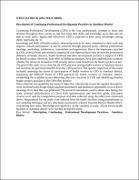| dc.description.abstract | OTILE PATRICK (2012-M121-10028)
Description of Continuing Professional Development Practices in Amolatar District
Continuing Professional Development (CPD) is the way professionals continue to learn and develop throughout their careers so that they keep their skills and knowledge up-to-date and are able to work safely, legally and effectively. CPD is expected to have many advantages among them; improving the 13
knowledge and skills of health workers, motivating them to be more committed to their work and improve overall performance. It can be achieved through personal study, clinical/ professional meetings, workshops, conferences, conventions and supervision. Due to the importance attached to CPD, several efforts and resources (material & non-material) have been devoted by government (Ministry of health, districts, health facilities) and other development partners in support of CPD for health workers. However, little effort or deliberate measures have been undertaken to ascertain whether the resources devoted to CPD actually derive some benefits to the health workers or not.
The goal of this study was to describe the CPD practices among health workers in Amolatar district and ascertain the perceived benefits from the CPD practices. The specific objectives of this study included: assessing the extent of participation of health workers in CPD in Amolatar district, examining the different forms of CPD practiced by health workers in Amolatar district, establishing the available factors enhancing effective execution of CPD and identifying benefits health workers associate to the CPDs they practice.
Data collection was guided by the research objectives whereby the researcher applied descriptive, cross-sectional study design employing both quantitative and qualitative approaches so as to derive meanings from data that was generated. The research instruments used to obtain data during this study included administration of Likert scale questionnaires and interview guide. Document reviews were used for triangulation purposes with data collected using the other tools mentioned above. Respondents for the study were selected from the health facilities using proportionate to size sampling technique and key informants purposively selected from the District Health Office, considering their stake, knowledge and experience on the variables of study. All the eleven health facilities in Amolatar district were reached during this study.
Key Words: Description, Continuing, Professional Development Practices, Amolatar Distric. | en_US |


